
Campanula rapunculoides
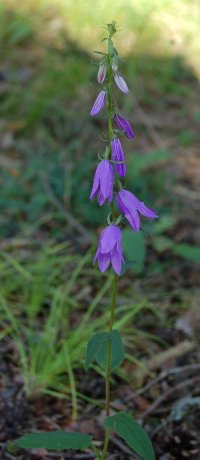
Epipactis atrorubens.
These were quite common on the hill just above the village - the path up through the Stations of the Cross (signposted Kalvarienberg) is a good place to find them!


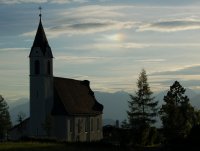
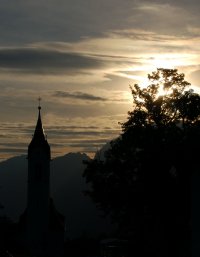
These notes are a brief summary of 7 days’ walking in the Tyrol near Seefeld. The weather was very kind, being mostly cool, clear and sunny. Ideal for mountain views, in fact. Adrian got to play with his new toy (the Nikon D50) and the boys got to fool around building arches and taking stereo pairs.
We arrived mid-afternoon from Munich in comfortable time for a walk up the hill above the village. Mösern is set right on the edge of the main Inn valley, and the Inntaler Hof is the last building in the village, so has splendid views over the valley. As you will see from the later pictures, there was definitely some weather on the way in from the west.
| Inn valley from Inntaler Hof. |  |
| Bellflower Campanula rapunculoides |
 |
| Helleborine Epipactis atrorubens. These were quite common on the hill just above the village - the path up through the Stations of the Cross (signposted Kalvarienberg) is a good place to find them! |
 |
| Evening light over the valley. Visibility was still quite reasonable - this was taken with the lens at 135mm so the mountains are a fair way away. |  |
| Sundog with church. Sundogs are usually a good indicator of incoming weather, as they form in hexagonal plates of ice typical of the cirrus cloud on the leading edges of weather fronts. |  |
| Incoming weather. The same scene a few minutes later. Really just an excuse to play with the exposure-lock on the camera! |  |
At breakfast it was raining quite hard, but by the time we set off it was mostly just dripping from the trees. We took a slightly deviant route here (easy and recommended) going over the shoulder of Hohe Munde to the Rauthhütte and on up as far as the Zugspitzeblick which has a splendid view over the upper Gaistal and is a perfect lunch stop. On the way down it really did rain, but had cleared nicely in time to take some dramatic shots of the little church opposite the Hotel Xander as we arrived.
Yes, that really is snow all over Hohe Munde and its pals. Never mind, we reckoned on it melting by the time we had hiked up the track to Wangalm, and had our eye on the summit of the Gehrenspitze if the clouds stayed away. As it happens, we timed it about right, taking on the path up through the last of the snow. By the time we came down, most of the snow had gone, which made keeping your feet a lot easier.
| Snow on Hohe Munde. | 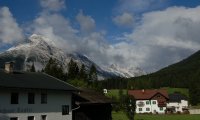 |
| Ahrnspitze from Xander. This is just to complete the balcony views - the boys had the east-facing room! | 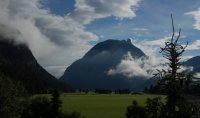 |
| Above Wangalm. If you are collecting points for a hat-badge, do call at the Wangalm hut which is worth 18 and get the stamp on your map! | 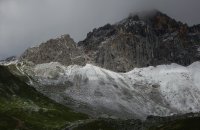 |
| Wetterstein ridge with snow. Still quite snowy up here, with some decent drifts behind the rocks. |  |
| Hohe Munde from Wangalm. | 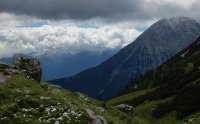 |
| Wangalm viewpoint. Just a nice place to hang around and take pictures! | 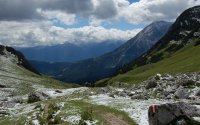 |
| Gehrenspitze from Scharnitzjoch. This is a superb viewpoint (even better in stereo) - probably rather better than the summit. But you have to get to the top, don't you! | 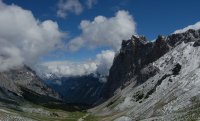 |
| Scharnitzjoch panorama. |  |
| Meadow above Scharnitzjoch. Wet snow on a 30deg grassy slope is quite tricky to walk on. | 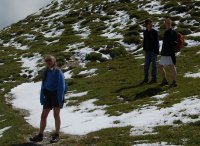 |
| Followed by Sheep. Poor deluded creatures were hoping to get fed, I suppose. They gave up on us a few minutes later. | 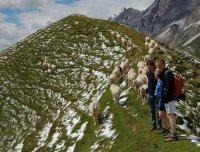 |
| Xander from above. Let's test the lens - this was looking quite small by now! |  |
| Wetterstein wall from Gehrenspitze. | 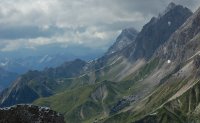 |
| Leutaschtal from Gehrenspitze. The next hotel (the HubertusHof) is tucked right into the far corner of the valley here. | 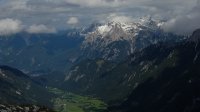 |
| Alpine Chough. Clearly regards humans as a useful source of crumbs, unless it was just waiting to pick our bones clean as we slid to our doom on the way down. | 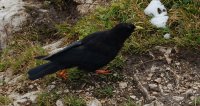 |
| Wetterstein Hütte from Wangalm. The hut only scores 6 hat-points but get its Stempl on the way down (as well as some excellent ApfelStrudel) - if you made the summit you deserve it! | 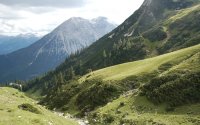 |
| Wetterstein wall later the same day. Now where has all that snow gone? | 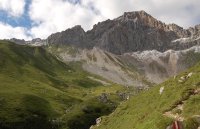 |
| A cow with a view. Nothing like a bit of cud-chewing foreground to get the photographer interested! | 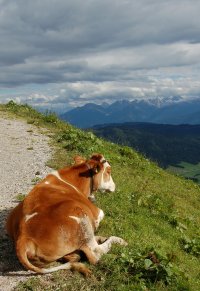 |
| View back from Wetterstein Hütte. | 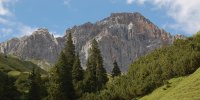 |
Definitely a loafing day - we ignored the walking notes and just ambled down the riverbank for a day’s skimming practice and waterworks construction.
The Gehrenspitze was worth about 3 nutcase points - this little hike was definitely at the upper end of the nutcase scale (but worth it). Not recommended unless you are feeling very fit, know you have all day, and trust the grips on your boots on the way down. However it is well worth investigating the lower and middle sections of the Bergleintal even if you don't make the Stempl at the hut.
Another gentle amble - we did this one in (walking) sandals! We made it in time to enjoy the 5-o'clock bell on the eminence just in front of the hotel.
Meadows with various knapweeds, thistles, vetches, bedstraw etc. Various yellow composites including one like a fleabane and another like a corn marigold but with bigger flowers. Scabious that I assume was Tyrolean (S. vestina) that also grew in woods. In woods interesting mixture of lime-lovers and acid (calcareous schist??? - more likely a thin weathered/leached layer on top of the lime, which is very hard so not porous) including 2 cow-wheats, tormentil, bilberry, bearberry?, ling, harebell or a close relative, a nice little group of dark red helleborine (Epipactis atrorubens) near Mösern and a few broad-lvd E. helleborine (mostly only in bud). At least two other campanula spp., one very small, bright blue, probably C. pusilla, and C. rapunculoides; one or two plants with bigger flowers that might have been C. persicifolia.
Woodland: almost exclusively pine and spruce, though there were areas of beech (interestingly almost no other broadleaves - even birch was in short supply), with a rich 'herb layer' including lily-of-the-valley leaves and masses of what I think were May lily Maianthemum bifolium leaves and berries. Herb paris was common, including specimens with 5 or even 6 leaves, though the flower parts were always in fours. Scabious of at least 2 sorts (Tyrolean and devilsbit I think). Patches of fragrant orchids in clearings, usually near small streams, along with seeding spotted orchids, probably Dactylorchis fuchsii. Dark red helleborines common everywhere, often in large groups, especially at lower levels, and broad-leaved helleborine also widespread. One group of half a dozen or so plants of red helleborine Cephalanthera rubra near the Wildmoossee.
Woodland edge/scrubby woodland had numerous exciting species, including red-berried elder Sambucus racemosa, stone bramble Rubus saxatilis and wolfsbane Aconitum vulparia a little higher up. Most exciting of all was martagon lily Lilium martagon, only seen once. One patch of brownish parasitic flowers that I hoped might be birdsnest orchid but I think were some kind of broomrape, and the superficially similar Dutchman's pipe Monotropa hypopitys.
Up in the mountains avens Dryas octopetala in full flower and hairy alpenrose Rhododendron hirsutum making a wonderful show. Yellow mountain saxifrage Saxifraga aizoides on slightly damper bits. A few gentians mostly on barish rock (not as many as I expected; probably Gentiana brachyphylla subsp. favrati since it was definitely limestone), moss campion, various small saxifrages and white poppies up at the Meilerhütte. These were probably Alpine poppies despite the fact the book says 1200-2000m and the hütte is 2372m. Also a mouse-ear (Cerastium sp.) with large white flowers. We were hoping to find edelweiss but did not [Richard tells me it is only really common at about 2700m which these mountains do not reach]. In amongst the rocks at around the 2000m mark all sorts of small cushions of classic "alpine" plants, but mostly not flowering - suspect rock jasmines or similar. In a fairly narrow altitude belt at c.2100m tiny yellow violets presumably Viola biflora (though they only seemed to have singleton flowers).
I don't know whether it was something to do with the time of year, but there were remarkably few birds about, even in the forest. I was hoping to see griffon vultures or even eagles, but no luck; even buzzards were uncommon. The only really exciting species was Alpine chough. As well as the freindly individual at the Gehrenspitze summit there was a flock of at least 100, making a very strange chirrupping call. There were also ravens about which we heard on various occasions but I only saw two. We heard a flock of crossbills, and I saw one medium-sized greyish bird in the pine forest that might have been a wryneck.
Buzzard
Alpine Swift
Swallow
Crag Martin
House Martin
White Wagtail
Blackbird
Song Thrush
Coal Tit
Great Tit
Marsh Tit
Crossbill
Alpine Chough
Raven
Just a few of the stereo pairs Richard took – which really make the slopes stand out!
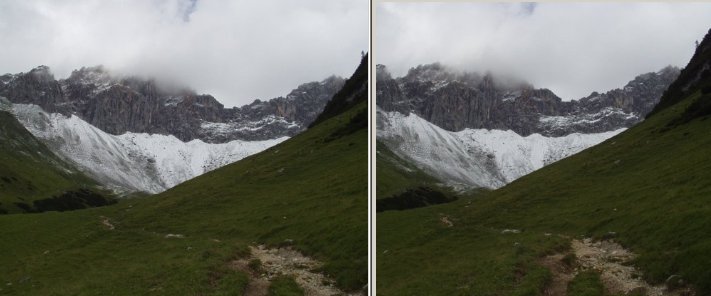
Snow on the lower slopes of the Wetterstein wall, seen from the meadow above Wangalm.
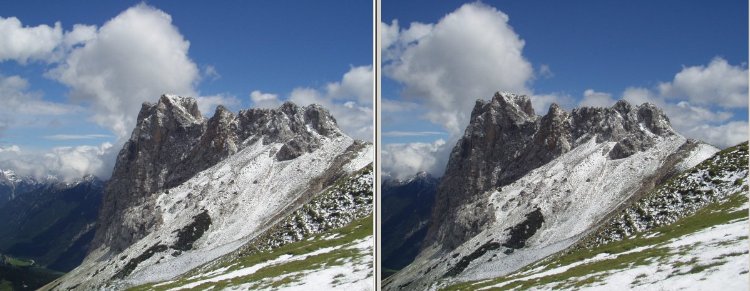
View towards Gehrenspitz walking up from Scharnitzjoch.

Snow and rocks in the foreground, looking down vertically into Puital.
Pictures by Adrian, Gill and Richard Smith © Copyright 2005